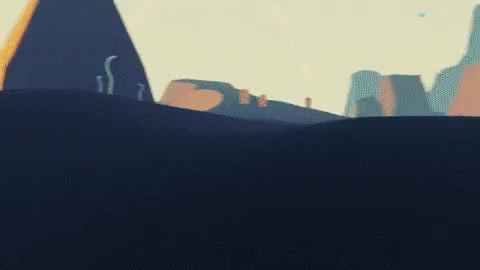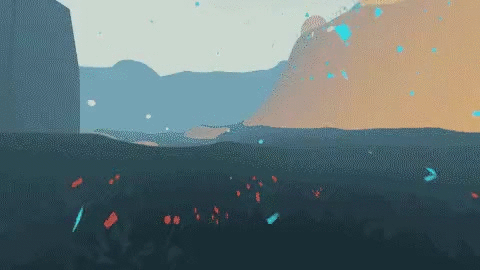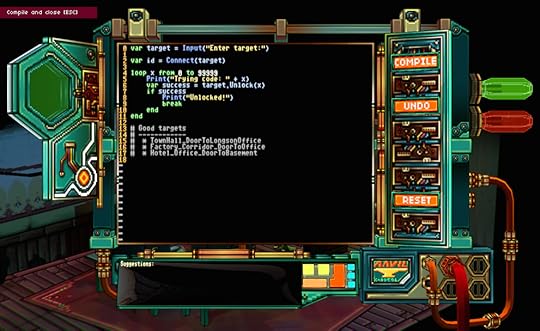Kill Screen Magazine's Blog, page 226
September 15, 2015
Corpse of Discovery is Franz Kafka for the twenty-second century
Corpse of Discovery recreates banal office life in deep space.
September 14, 2015
New Shape of the World gifs show off strange creatures and falling monuments
Shape of the World is pure joy. It’s a game about finding your place in the world as much as it is being lost in it—about learning how to be lost while still feeling like you belong. As you wander through its colorful biomes, life sprouts up all around you, in real time. Shrubbery bubbles up like foam from the earth, brittle trees snap upright along the path, rocks fall from the sky and take root in the ground as if they were there all along.
a good look at the vast scale and dynamism of Shape of the World
My short time with it at this past E3 left me yearning to see more of what its strange worlds had in store, and luckily for me (and you!), Shape of the World is one of the more gif-able games out there. Its creators take full advantage of the fact, too, and have posted some new and lovely clips from the game for Screenshot Saturday over on Twitter.

Among the new gifs is a look at some new animal life I’ve yet to see in the game myself: little scuttling jellyfish-like things that seem to launch into the air when frightened, and dancing serpents that emerge from the ground like garden eels. Some of the earliest videos of Shape of the World showed off hints of its inhabitants, which included little flocks of ghost-like creatures that I recall livening up the skies in my demo from E3.

Another gif shows huge spherical monuments toppling off a cliff and half burying themselves into the valley below, which offers a good look at the vast scale and dynamism of Shape of the World’s thriving locales.

See more Shape of the World on its website.
Merrily Perily is a comedy of errors about poison and pooping yourself
There’s a certain type of prank prevalent on YouTube where the prankster dribbles hot sauce onto a friend’s food and also into their drink, so that once they eat the food and realize the predicament they’re now in, reaching for their drink will only make things worse.
Merrily Perily takes that prank and stretches it out into an entire game. The game casts the player as Perry, a man who wanders into a village suffering from dehydration. You ask all the villagers for help, but for some reason, they’re all extremely standoffish and seem dedicated only to wasting your time. With time running down, you resort to drinking out of a fountain, but oh no, a snake jumps out of the fountain and bites you! You run to the hospital for some anti-venom, but the anti-venom then gives you diarrhea. You go to an outhouse for relief, but then you’re dehydrated again!
why is everyone in this town such a dick?
The cycle continues on and on like this, with each solution to your present status effect only presenting you with a new status ailment. It’s a comedy of errors that requires quick thinking as you bounce from predicament to predicament, knowing that letting the clock run out on any one status effect before getting it cured will result in a game over. In the meantime, you’re drawn into the world by one simple mystery: why is everyone in this town such a dick?
Merrily Perily is available now for PC.
[image error]
For the consumer who has everything, it's the phone that does nothing
At least it cannot be damaged by water.
Life's problems are given a beautiful mystique in WEAVE
Problems are no longer immaterial in Nadav Tenenbaum's "abstract journey" WEAVE. They rise up silently from the seas as huge spheres of ebony, blocking out the sun. Or they take up all your living space as unconquerable Sisyphean boulders. Problems cannot be ignored and they will find you.
This is what we're left to interpret, at least. For Tenenbaum refuses to tell us. That would be counter-intuitive. "There is a thematic structure present, but the lines defining that structure are invisible, and the player must connect the dots to grasp the big picture," writes Tenenbaum about WEAVE.
something resembling a shared dream.
The game is a rare and beautiful example of the merits of abstract storytelling when combined with the interaction that videogames offer. We know that WEAVE's two characters have a problem that they're trying to deal with. But we don't know what, precisely, these problems are. We can guess at them but never truly know. Details are obfuscated in favor of playing to a mystique that sees separate events strung together like spilled paint, transitioning not with a logical sense of place, but by whole screenfuls of color.
[image error]
The result is something resembling a shared dream. Pinches of reality are seen at the start before the characters are stolen by curiosity or a need to escape and taken to the fantastic. One of them becomes trapped in a labyrinthine collection of identical criss-crossing stairs. The other sees the problem sphere morph into a puzzle box that they must solve within an empty landscape. These separate events are joined as one by the use of cross-cutting: each character is given a single interaction or puzzle before it shifts back to the other one, neither character being allowed to resolve a scene in one go, only as a series of interrupted moments. This constant back-and-forth in narrative focus may be what the title refers to.
It's easy to see how the visuals in WEAVE tell a story even if you have to take wild stabs at what each symbol and scene correlates to. But what about the interactions? It could be argued that they serve nothing else but to give you something to do. It's prey to the "not a game" argument. And it's true, you do only click the mouse on occasion, maybe to open a door, or push an object and you have no choice in the matter if you want to progress. There are unquestionably two simple puzzles in the game but what else is there aside from that?
means nothing to us at first.
I'd say that the interactions are there to add our own tangible hesitation to the characters. While the confusion of not knowing what the hell is going on may already make us apprehensive before clicking to progress, the soundtrack adds further fear, it being an ominous ambiance the majority of the time. So when the woman looks at her front door quizzically, so do we, and together we wonder who or what is behind it. The game waits for us as she poses in front of the door, ready to open it, but dare we? She won't do it without us. But will this next click of the mouse lead to a terrible end for this woman? It's a risk we have to take. But not until after looking through the door's peephole.
It's worth analyzing how Tenenbaum engineers this moment of hesitation. We've only just met the woman at this point so why do we care about what happens to her? It's the interaction that comes before this front door scene that does all the work. After leaving the first character behind in the scene before, the camera cuts, and we see only a black rectangle in white space. As with the game's storytelling, it's abstract and means nothing to us at first. Not recognizing anything in this shot, we click to see what happens, hoping to grasp at some comprehension of what we're looking at.
[image error]
Upon that click, the camera zooms out as the sound of a piano note rings out. It's at this moment we realize that we were looking at the black and white keys of a piano, just up close. Click once more and the same happens: we zoom out again, and another note is sent into the air. Upon the third click, the camera changes angle completely to show us the woman sat at her piano. It was a first-person perspective all along, and so, as we played the piano so did she. We shared a playful moment with her. Now we are connected: she is us and we are her. With that established, we see her as somewhat of a surrogate body, and so we might fear for what happens to her. This is when she moves to the scene at the door described before.
You could compare this interactive technique with many other videogames. It's commonly used to unite the player with the virtual character. And it's beyond merely matching a button press on a controller with, say, the character jumping. It's closer to the effect motion controls achieve, which may have us make a downward motion to pull a lever down, or make slashing motion to swipe with a sword. Other examples include Dead Space's interface which, as Tiny Design writes, "reinforce the inability to escape the environment," drawing us closer to the character's situation and vulnerability.
What's magnificent about WEAVE is that, to use Tenenbaum's phrasing, its structures are made invisible to us. The tricks used to pull us in happen without us seeing them. We are transported as if on a magic carpet through each scene, the interactions we make blended with camerawork and a character's behavior, which allows us to focus on deconstructing the visuals as we try to unravel meaning.
Turning down the volume on Volume
Mike Bithell’s game is primally fun, but preachy.
Vignettes will tell a wordless story through shapeshifting objects
Vignettes is an adorable looking game about rotating adorable tiny objects in such a way that transforms them into other adorable tiny objects. The little shapeshifting things tell an “underlying story,” making each individual item a vignette of their own.
A telephone becomes a television set which becomes a cooking pot. What is at first a mandolin is suddenly a bowl, then a crown, then a ring. And it goes on and on.
Its creators Pol Clarissou and Armel Gibson call Vignettes a “contemplative game,” something they aren’t strangers to. An older game of Gibson’s, Gulag Paradise, turned forced labor into a typing game, and Clarissou’s recent Station Fantôme rendered you immobile in the dark and ghostly tunnels of an abandoned subway system.
Vignettes looks a thousand times more delightful in tone, but given the games these two have worked on, who knows what horrors await in those little spinning trinkets?
Everyday things become new and interesting
Or maybe Vignettes really will be a nice, peaceful toy-like experience. Its thoughtful simplicity calls to mind similarly meditative games like Mountain and the recently released succulent-growing sim, Viridi. Like them, exploration of an object, rather than a space, is at the core of Vignettes. Everyday things become new and interesting when examined out of context, or placed in unusual association with other, unrelated things, and it seems Vignettes will dive into that to some degree.
You can find more information about Vignettes on its website and devlog.
The horror of Resident Evil 2's police station
The impossible spaces of Resident Evil 2 recall The Shining’s Overlook Hotel.
September 11, 2015
Make friends and hack reality when Else Heart.Break() drops on September 24th
Else Heart.Break() makes me want to smoke cigarettes. It's not that I don't value my health. It's that being a smoker seems to be the easiest way to people's hearts in the game. If you smoke, you can say "yes" when strangers ask if you have either a) a lighter, or b) a smoke. With that icebreaker a whole range of social possibilities open up.
"So, what's your story?" the person might ask as they take their first drag, thanking you between pursed lips. You've met someone because you both smoke and now you're chatting. The alternative is remaining seated in the smoke-free corner of the club while the disco lights spin across your glazed face. How fun.
This might be one of the possible intersections in else Heart.Break(). We'll find out soon enough as it's coming out on September 24th. But, actually, there's another option that I've missed out. It's possible to hack the reality of the game's world to make friends so you can skip all the anxiety of actually talking to them first. This is, after all, a place "where bits have replaced atoms."
Can I hack myself?
The idea is to help the city of Dorisburg's newest arrival Sebastian to find his place. He's moved in among the hackers and activists and just landed his first job, but he's out to discover himself, to step into his adult life. How he does this and where he ends up is left to you. And this freedom is important. Creator Erik Svedang emphasizes the efforts he's gone through to ensure that the city is "meticulously simulated," with citizens going about life on their own accord, and loads of everyday objects and computers working and being modifiable.
The big question is how far can you go? The end of the new trailer shows Sebastian hacking an arcade cabinet in order to get the highest score on its leaderboards. It's a synecdoche that leads to more questions: can I hack myself a better job? Can I hack someone to fall in love with me? Can I hack myself?

It's easy to spiral out of control with this Matrix-like discourse ("What is real?"). But Else Heart.Break() isn't about that. Svedang wants it to be a "laid-back experience" first and foremost. That's why, if everything becomes too much, you can take a stroll into a nearby café, sit down on a chair of your choosing, and drink a slow cup of coffee.
Else Heart.Break() is coming to Windows, Mac, and Linux on Steam and the Humble Store on September 24th. Check out its website for more info.
Fight monsters or kiss them? Undertale will let you decide when it arrives next week
Kickstarter darling Undertale came into our lives in 2013 with the scent of butterscotch-cinnamon pie. It cradled us in its furry arms, gave us comforting and encouraging glances, before leaving us to rot—cold and alone—for two long years. Now, it's finally returning next Tuesday the 15th, and I can already feel my heart swelling for the conflict resolution haven that is Undertale's world.
talking through your feelings with violent enemies
Playing as a naive human child, you find yourself trapped in the Ruins, an underworld where the humans banished all manner of monsters long ago. Luckily, early on in your journey you meet Toriel, a lamb-like mother figure who wants to do nothing but protect you from the cruelty of both worlds. To get back home, you must cross treacherous territory and it's up to you to decide how you will handle all the monstrous curiosities you meet along the way.
You can either take the traditional path of fighting, leveling up, gold, and XP. Or, you say screw tradition, and blaze your own trail filled with patience, caring, and talking through your feelings with violent enemies. You can kiss them, chat them, cheer them. Or you can annihilate them. It's your decision to make (though you can't stop other animals from judging you for your choices). Either way, you enter into battle mode and must protect your heart (your very soul and health bar) from their incoming attacks.
As is clear from the release trailer, Undertale is not the kind of subversive game with a self-serious or self-aggrandizing attitude. But don’t let its adorable, gooey warm center fool you, either. Undertale has the potential to say something profound about nostalgia, growing up, and parenthood. Creator Toby Fox has designed a game that uses convention and genre to call the players attention to something both familiar and new.
don’t let its adorable, gooey warm center fool you
Though the pacifist mode can feel repetitive at times in the demo, taking another pass with the guns a'blazin' mentality doesn't really make the game any easier or less repetitious, either. You realize instead of asking players to kill over and over again, designers could just as easily ask them to solve social puzzles and navigate emotional obstacles. It's subversion of genre that still manages to feel organic and true to itself, inviting you to imagine more delightfully alternative forms of play without beating you over the head with it.

The new trailer teases all sorts of new whacky additions, like some sort of skeleton man whose sole purpose seems to exclusively revolve around annoying you randomly. Thankfully, the spider bake sale is still going strong, and we're still left to wonder what baked goods made "by spiders, for spiders, and of spiders" actually tastes like. Most importantly, Undertale's bizarre core—which teeters between mothering and madness—appears if not wholly unchanged, still stronger than ever.
You can play Undertales's old demo here. Be sure to check it out the Steam on its release day next Tuesday for the full game on Mac and PC.
Kill Screen Magazine's Blog
- Kill Screen Magazine's profile
- 4 followers



